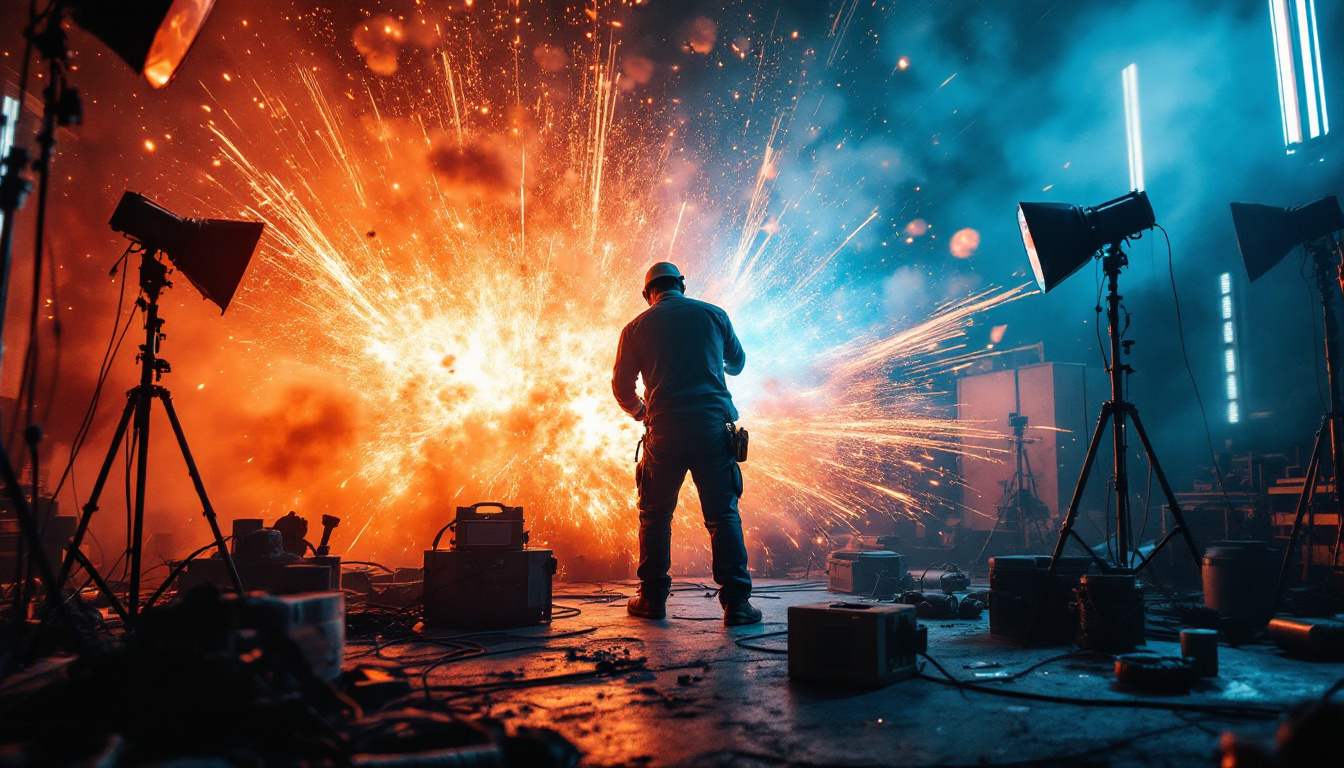
In the world of lighting and electrical contracting, understanding the materials that interact with light is crucial. While most materials are designed to withstand light exposure, some can react in unexpected and dangerous ways. This article delves into the phenomena of materials that can explode or react violently when exposed to certain types of light, providing valuable insights for lighting contractors.
Light is a form of electromagnetic radiation that can interact with various materials in different ways. Understanding how light interacts with materials is essential for contractors who work with lighting systems. This interaction can lead to changes in the material’s physical properties, potentially resulting in explosive reactions under certain conditions. The study of light-matter interaction not only informs safety protocols but also enhances the aesthetic and functional aspects of lighting design. By grasping these principles, contractors can optimize their installations for both performance and safety.
Different types of light, including ultraviolet (UV), visible, and infrared (IR), can have varying effects on materials. Ultraviolet light, for instance, is known for its ability to break chemical bonds in certain substances, leading to degradation or explosive reactions in some cases. Understanding these effects can help contractors choose appropriate materials for their projects. Visible light, while less damaging, can still cause fading in pigments and dyes, which is crucial for maintaining the aesthetic quality of finishes in architectural applications. Infrared light, on the other hand, primarily generates heat, which can affect temperature-sensitive materials and influence their structural integrity over time.
Some materials are more susceptible to explosive reactions when exposed to light. For example, certain organic compounds, particularly those containing nitrogen, can become unstable when exposed to UV light. This instability can lead to rapid decomposition, resulting in an explosive reaction. Contractors should be aware of these materials when designing lighting systems that may expose them to intense light. Additionally, metals can also react to light exposure, especially when they are coated with specific paints or finishes that may degrade under UV radiation. Understanding the compatibility of materials with different light types is crucial for ensuring long-term durability and safety in construction projects. Furthermore, the choice of protective coatings can mitigate some of these risks, allowing for safer use of materials that might otherwise be vulnerable to light-induced reactions.
While many materials are safe for use in lighting applications, a few are particularly noteworthy due to their potential for explosive reactions. Understanding these materials can help contractors avoid dangerous situations.
Hydrogen peroxide is a common chemical used in various applications, including cleaning and disinfection. However, when exposed to light, especially UV light, it can decompose rapidly, releasing oxygen gas and heat. In a confined space, this reaction can lead to an explosive situation. Contractors should handle hydrogen peroxide with care, ensuring it is stored in opaque containers to minimize light exposure. Additionally, it is important to note that the concentration of hydrogen peroxide can significantly influence its stability; higher concentrations are more prone to rapid decomposition. Therefore, contractors must be vigilant about the concentration levels they are working with and adhere to safety protocols, including using appropriate personal protective equipment (PPE) and ensuring adequate ventilation in work areas.
Organic peroxides are another class of materials that can pose significant risks when exposed to light. These compounds are often used as initiators in polymerization reactions. However, they can decompose violently when exposed to UV light or high temperatures. Proper storage and handling practices are essential to prevent accidental exposure to light, which could lead to explosive reactions. Furthermore, organic peroxides vary widely in their stability and reactivity; some may be relatively stable at room temperature, while others can be shock-sensitive and require refrigeration. Contractors should familiarize themselves with the specific types of organic peroxides they are using, including their hazard classifications and recommended handling procedures, to ensure a safe working environment.
Chlorates and perchlorates are chemicals commonly used in pyrotechnics and explosives. When exposed to light, they can become highly reactive, leading to explosive decomposition. Contractors should be cautious when working near these materials, ensuring that they are stored away from light sources to minimize the risk of accidental ignition. Additionally, the presence of contaminants or impurities can exacerbate the instability of chlorates and perchlorates, making it crucial for contractors to use high-purity materials and to maintain strict cleanliness in their work areas. Understanding the specific conditions under which these chemicals can become hazardous, such as the presence of moisture or certain metals, can further enhance safety protocols and prevent potentially catastrophic incidents.
Given the potential risks associated with certain materials, it is crucial for lighting contractors to implement preventative measures. By taking proactive steps, contractors can minimize the likelihood of explosive reactions occurring in their projects.
One of the most effective ways to prevent explosive reactions is through careful material selection. Contractors should prioritize materials that are known to be stable under light exposure. This includes choosing light fixtures and wiring that are designed to withstand UV radiation and other forms of light without degrading. Additionally, selecting materials with low flammability ratings can further enhance safety. For instance, using LED fixtures not only reduces energy consumption but also generates less heat, thereby decreasing the risk of ignition in sensitive environments.
For materials that are known to react explosively with light, proper storage and handling are essential. This includes using opaque containers for chemicals like hydrogen peroxide and organic peroxides, as well as ensuring that chlorates and perchlorates are stored in dark, cool environments. Training staff on the risks associated with these materials can also help prevent accidents. Furthermore, implementing a clear labeling system for hazardous materials can aid in quick identification and proper handling, reducing the chances of mismanagement during projects. Regular audits of storage practices can also ensure compliance with safety standards, fostering a culture of safety among all team members.
Monitoring environmental conditions, such as temperature and light exposure, can also play a crucial role in preventing explosive reactions. Contractors should consider installing sensors that can detect changes in light levels and temperature, providing real-time data that can help identify potential hazards before they become serious issues. Additionally, integrating these sensors with a centralized monitoring system can allow for remote access and alerts, enabling contractors to respond swiftly to any anomalies. Regularly scheduled inspections of the work environment, alongside the use of these technologies, can further enhance safety protocols, ensuring that all potential risks are addressed promptly and effectively.
To effectively mitigate risks associated with materials that explode upon light exposure, it is essential to understand the underlying science. This knowledge can empower contractors to make informed decisions and enhance safety protocols.
Chemical stability refers to a material’s ability to maintain its structure and properties under various conditions. When certain materials are exposed to light, particularly UV light, their chemical bonds can break down, leading to instability. Understanding the specific wavelengths of light that can cause these reactions is key for contractors working with sensitive materials.
Temperature plays a significant role in the stability of materials exposed to light. Higher temperatures can accelerate chemical reactions, making materials more prone to explosive decomposition. Contractors should be aware of the temperature ranges in which specific materials are stable and take steps to maintain those conditions during installation and use.
Examining real-world incidents can provide valuable insights into the risks associated with materials that react explosively to light. These case studies highlight the importance of proper handling and awareness in the field.
In one notable incident, a cleaning crew inadvertently exposed hydrogen peroxide to direct sunlight while transporting it in a clear container. The resulting decomposition led to a rapid release of oxygen gas, causing the container to rupture violently. This incident underscores the importance of using opaque containers and ensuring that hazardous materials are shielded from light exposure.
Another case involved a laboratory that used organic peroxides as part of its research. Due to inadequate storage practices, the peroxides were exposed to UV light from nearby fluorescent fixtures. The resulting decomposition led to an explosion, causing significant damage to the facility. This incident highlights the need for strict adherence to storage guidelines and the importance of training staff on the risks associated with these materials.
Understanding the materials that can explode upon exposure to light is essential for lighting contractors. By being aware of the risks associated with certain chemicals and implementing preventative measures, contractors can enhance safety in their projects. Material selection, proper storage and handling, and monitoring environmental conditions are all crucial steps in minimizing the risk of explosive reactions.
As the field of lighting continues to evolve, staying informed about the latest safety protocols and material science is vital. By prioritizing safety and education, lighting contractors can ensure that their projects are not only successful but also safe for everyone involved.
At LumenWholesale, we understand the importance of safety and efficiency in lighting projects. That’s why we offer contractors an unbeatable selection of spec-grade lighting products that meet the highest industry standards. Say goodbye to inflated markups and hello to top-quality lighting at wholesale prices. With our hassle-free bulk buying and free shipping, you can trust that you’re getting premium lighting at the best value — every time. Elevate your lighting installations with the perfect blend of quality, affordability, and convenience. Wholesale Lighting at the Best Value is just a click away.

Discover the transformative power of low profile track lighting with expert insights from seasoned lighting contractors.

Discover innovative strategies from smart lighting contractors as they illuminate urban landscapes with sidewalk LED lights.

Discover innovative cost-saving strategies for lighting contractors with the Solar Ball Lamp.

Discover the essential checklist for lighting contractors focusing on AC receptacles.